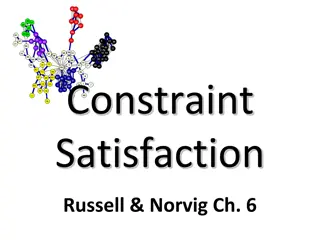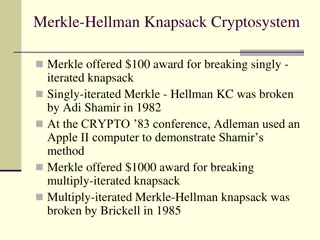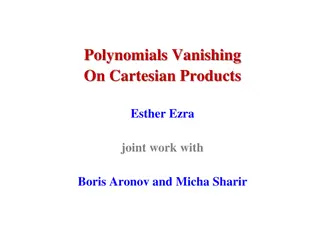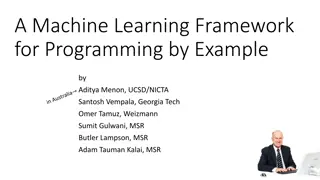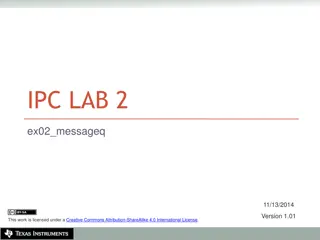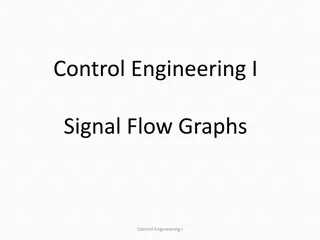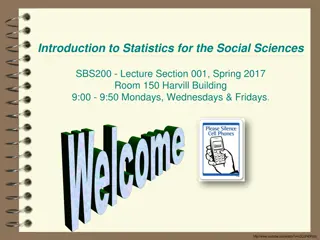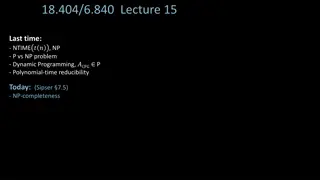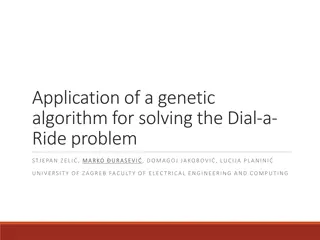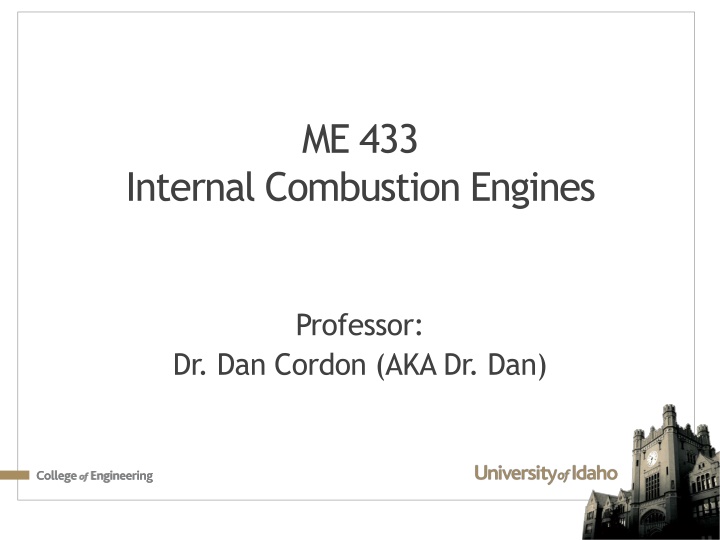
Internal Combustion Engines Lecture Key Variables and Equations
Explore key variables such as Brake Torque and Power, along with important equations for Power, Torque, and SFC in the context of internal combustion engines. An example problem involving a Chevy 350 truck engine is analyzed to predict peak power and torque. Unit conversions and detailed calculations are provided for power and torque estimations.
Download Presentation

Please find below an Image/Link to download the presentation.
The content on the website is provided AS IS for your information and personal use only. It may not be sold, licensed, or shared on other websites without obtaining consent from the author. If you encounter any issues during the download, it is possible that the publisher has removed the file from their server.
You are allowed to download the files provided on this website for personal or commercial use, subject to the condition that they are used lawfully. All files are the property of their respective owners.
The content on the website is provided AS IS for your information and personal use only. It may not be sold, licensed, or shared on other websites without obtaining consent from the author.
E N D
Presentation Transcript
ME 433 Internal Combustion Engines Professor: Dr. Dan Cordon (AKA Dr. Dan)
Key Variables from Lecture 6 Tb Brake Torque Pb Brake Power IMEP Indicated Mean Effective Pressure BMEP Brake Mean Effective Pressure BSFC Brake Specific Fuel Consumption ?? - Combustion Efficiency ?? - Mechanical Efficiency ?? - Thermal (Cycle) Efficiency ?? - Fuel Conversion Efficiency ?? - Overall Efficiency (Net Efficiency) ?? - Volumetric Efficiency Note: ??= ?? (different textbooks) AFR Air to Fuel Ratio (by mass) F/A Fuel to Air Ratio (by mass) B Bore L Stroke lrod Connecting Rod Length CR Compression Ratio Vmax = VBDC Vmin = VTDC = Vc (clearance volume) Vd = Vswept Displaced Volume ?? Mean Piston Speed nR Number of revolutions per cycle N Engine Speed QHV Heating Value of Fuel ?? - Mass Flow Rate of Fuel ?? - Mass Flow Rate of Air
Power, Torque, and SFC Equations ? ?2 ? ???? ? 4 1 1?? ?? ? =?? ?? ?? ??? ?? ???? ? ???? ??? ?2 ? ???? 1?? ?? ? =?? ?? ?? ??? ?? ???? ? ???? ??? 8 1 1 1 ??? = = ?? ??? ?? ???
Example Problem Predict the peak power and peak torque of the 1975 Chevy 350 truck engines that you played with in your previous homework. Here are the inputs we will use, along with some justification Q_hv = 18,659 [Btu/lbm] or 43.4 [MJ/kg] (lower heating value of gasoline) AFR = 12:1 (richer than stoichiometric, so combustion efficiency will be low) Pbdc = 14 [psia] (nearly atmospheric since WOT) Rair = 53.34 [ft*lbf/(lbm*R)] Tbdc = 95 [F], which is 555 [R] Bore = 4.00 [in] Stroke = 3.48 [in] CR = 8.5:1 ncyl = 8 nR = 2 (four-stroke engine) ??= 1 ??= 0.734, from (12/14.7)*0.90 @ Peak Power ??= 0.65 ??= 0.70 N = 4000 [rpm], or 66.7 [rev/sec] 1 ??? 1where k=1.3 for a fuel/air mixture = 0.474 @ Peak Torque ??= 0.75 ??= 0.75
Power Calculation ? ?2 ? ???? ? 4 1 1?? ?? ? =?? ?? ?? ??? ?? ???? ? ???? ??? Using the grid method to keep track of units 0.65 0.474 0.734 18,659 Btu lbm 12 lbm 0.7 14 lbf lbm* R 3.14 4 in 4 in 3.48 in 8 66.7 rev cycle 1 ft 1.414 hp *sec 4*0.88 2 rev 12 in lbm in^2 53.34 lbf*ft 555 R sec Btu Unit conversions P = 182 hp This engine was rated at 175 hp, but that includes some parasitic losses from things like water pump and alternator that we did not account for.
Torque Calculation ?2 ? ???? 1?? ?? ? =?? ?? ?? ??? ?? ???? ? ???? ??? 8 1 Using the grid method to keep track of units 0.75 0.474 0.734 18,659 Btu lbm 12 lbm 0.75 14 lbf lbm* R 4 in 4 in 3.48 in 8 cycle 2 rev 1 ft 12 in 778 ft*lbf Btu lbm in^2 53.34 lbf*ft 555 R 8*0.88 Unit conversions T = 295 ft*lbf This engine was rated at 250 ft*lbf, which occurred at 2500 RPM. My guesses for mechanical and volumetric efficiency were probably a little optimistic for this engine.



